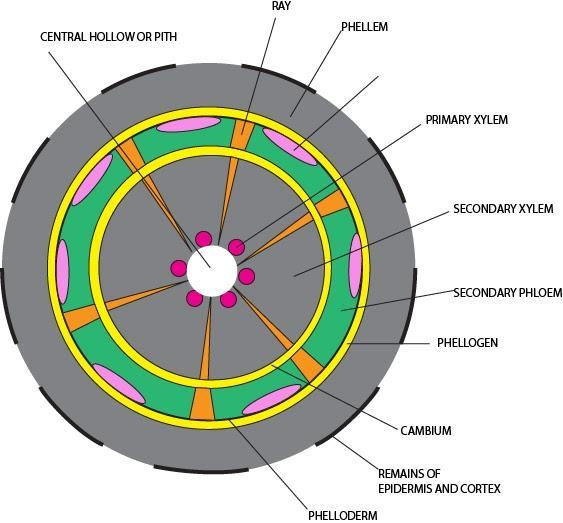
Youngest layer of secondary xylem is located
(a) In the center of the stem
(b) Just outside pith
(c) Just outside the vascular cambium
(d) Just inside the vascular cambium
Answer
492.6k+ views
Hint: It is composed of tracheary elements, rays, fibers, and interspersed axial parenchyma cells. The tracheary components comprise of just tracheids, as in a couple of vesselless angiosperms (e.g., Winteraceae), or of the two tracheids and vessel components, as in by far most of the angiosperms.
Complete answer
The arrangement of the vascular cambium is started when cells between the sections of vascular tissue interface the cambia inside the segments of vascular tissue to frame a total chamber around the stem. The cells formed toward the within are called secondary xylem or wood and people formed toward the surface of the cambium are called secondary phloem.
Xylem formation begins when the actively dividing cells of growing root and shoot tips produce primary xylem. The secondary xylem comprises the fundamental aspect of a developed stem or root in woody plants and is made in light of the fact that the plant grows in circumference and fabricates a loop of new xylem around the first essential xylem tissues.
At the point when this occurs, the primary xylem cells pass on and lose their leading capacity, framing an extreme skeleton that serves just to help the plant. Hence, inside the storage compartment and more established parts of an outsized tree, just the external secondary xylem (sapwood) serves in water conduction, while the internal part (heartwood) comprises dead yet basically solid essential xylem. In this way, the most youthful layer of secondary xylem is found simply inside the vascular cambium and not in the focal point of the stem, outside essence, or outside vascular cambium.
Additional information
Secondary xylem is missing in non-woody plants yet is available in trees and bushes. Its cell walls are thickened by the deposition of lignin, subsequently, delivering mechanical help to such plants. Secondary xylem comprises tracheids and vessels that are more limited and more extensive than those of primary xylem. It is additionally more extravagant in xylem filaments than in primary xylem.
So the correct answer is ‘Just inside vascular cambium’.
Note:
Secondary xylem is the type of xylem formed from secondary growth. In comparison, the first xylem forms during primary growth. Because of this, the secondary xylem is related to lateral growth instead of vertical growth as within the primary xylem. Another difference lies in the type of cambium that gives rise to them. The primary xylem originates from the procambium while the secondary xylem develops from the vascular cambium.

Complete answer
The arrangement of the vascular cambium is started when cells between the sections of vascular tissue interface the cambia inside the segments of vascular tissue to frame a total chamber around the stem. The cells formed toward the within are called secondary xylem or wood and people formed toward the surface of the cambium are called secondary phloem.
Xylem formation begins when the actively dividing cells of growing root and shoot tips produce primary xylem. The secondary xylem comprises the fundamental aspect of a developed stem or root in woody plants and is made in light of the fact that the plant grows in circumference and fabricates a loop of new xylem around the first essential xylem tissues.
At the point when this occurs, the primary xylem cells pass on and lose their leading capacity, framing an extreme skeleton that serves just to help the plant. Hence, inside the storage compartment and more established parts of an outsized tree, just the external secondary xylem (sapwood) serves in water conduction, while the internal part (heartwood) comprises dead yet basically solid essential xylem. In this way, the most youthful layer of secondary xylem is found simply inside the vascular cambium and not in the focal point of the stem, outside essence, or outside vascular cambium.
Additional information
Secondary xylem is missing in non-woody plants yet is available in trees and bushes. Its cell walls are thickened by the deposition of lignin, subsequently, delivering mechanical help to such plants. Secondary xylem comprises tracheids and vessels that are more limited and more extensive than those of primary xylem. It is additionally more extravagant in xylem filaments than in primary xylem.
So the correct answer is ‘Just inside vascular cambium’.
Note:
Secondary xylem is the type of xylem formed from secondary growth. In comparison, the first xylem forms during primary growth. Because of this, the secondary xylem is related to lateral growth instead of vertical growth as within the primary xylem. Another difference lies in the type of cambium that gives rise to them. The primary xylem originates from the procambium while the secondary xylem develops from the vascular cambium.

Recently Updated Pages
Why are manures considered better than fertilizers class 11 biology CBSE

Find the coordinates of the midpoint of the line segment class 11 maths CBSE

Distinguish between static friction limiting friction class 11 physics CBSE

The Chairman of the constituent Assembly was A Jawaharlal class 11 social science CBSE

The first National Commission on Labour NCL submitted class 11 social science CBSE

Number of all subshell of n + l 7 is A 4 B 5 C 6 D class 11 chemistry CBSE

Trending doubts
Differentiate between an exothermic and an endothermic class 11 chemistry CBSE

10 examples of friction in our daily life

One Metric ton is equal to kg A 10000 B 1000 C 100 class 11 physics CBSE

Difference Between Prokaryotic Cells and Eukaryotic Cells

1 Quintal is equal to a 110 kg b 10 kg c 100kg d 1000 class 11 physics CBSE

State the laws of reflection of light




